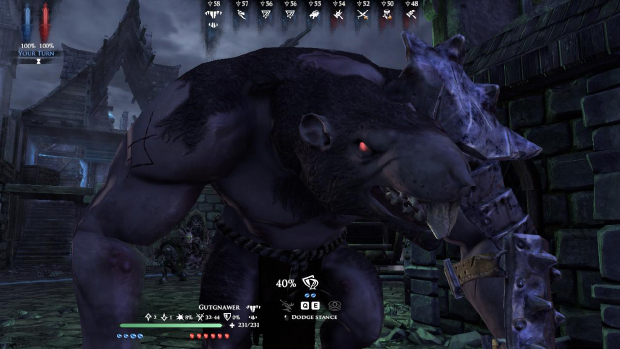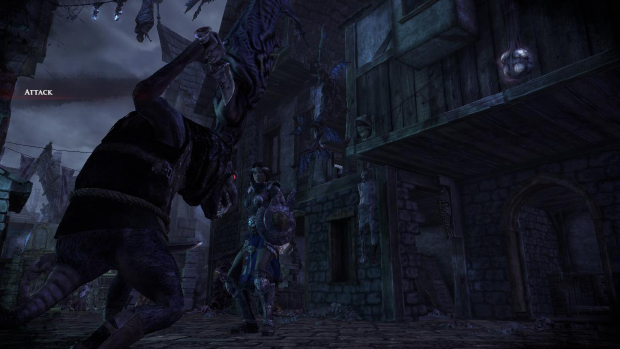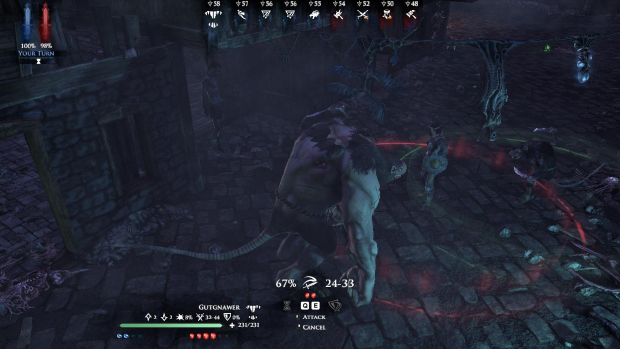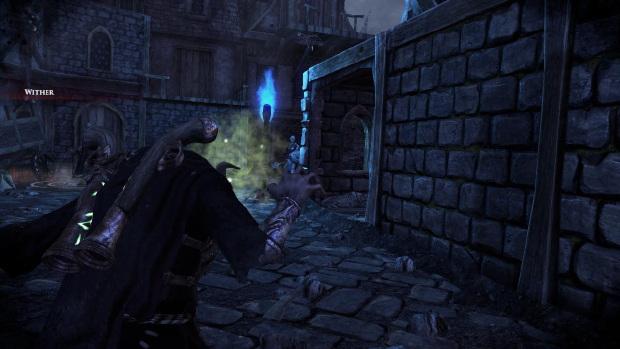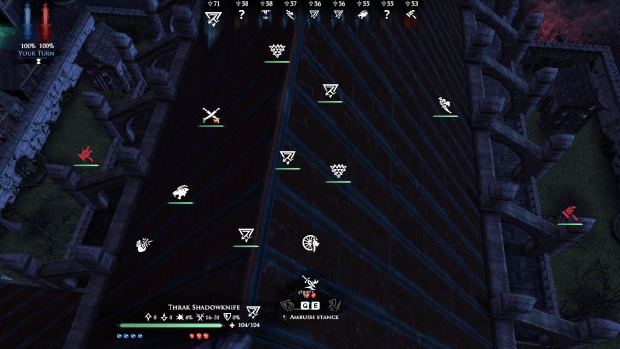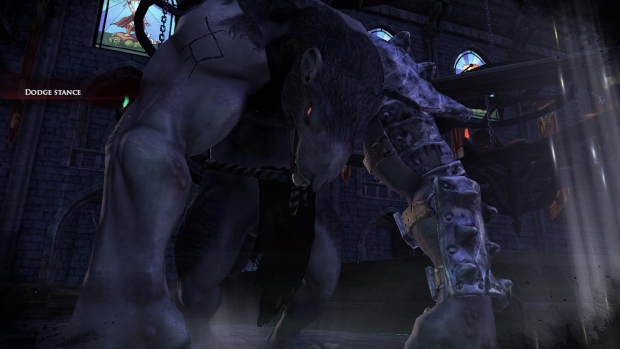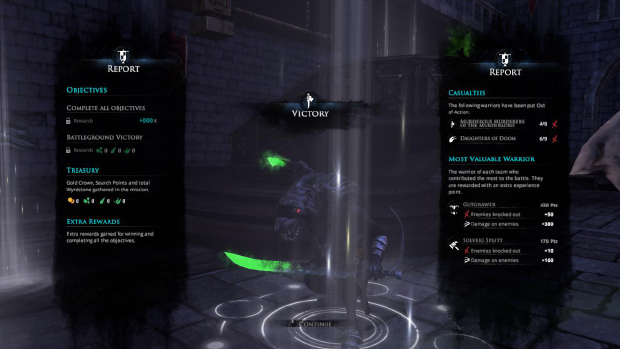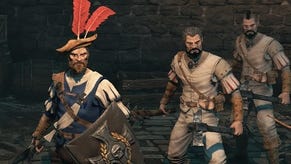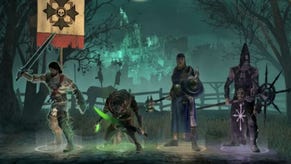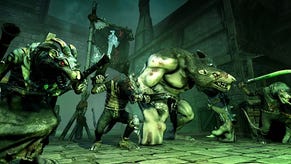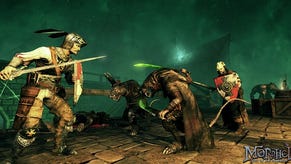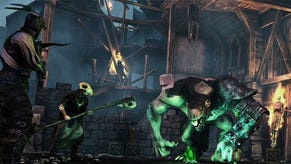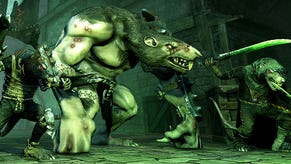Premature Evaluation: Mordheim: City of the Damned
Of Mice and Men
Each week Marsh Davies bleeds for you in the cold, accursed alleys of Early Access and comes back with any stories he can find and/or a repulsive corruption born of arcane mutagenic powers. This week he and his band of rat-men scuttle through the streets of Mordheim: City of the Damned - a turned-based tactics game set in the world of Warhammer. Fellow Skaven-fancier Adam had a slightly cool impression of it last November, but have the subsequent five months made a whisker of a difference?
I clutch the Warpstone between my yellowing talons and stare into its abyssal dark. Space seems to buckle before me as I channel the Chaotic energies of Adam’s previous article, a terrible vaporous simulacra of his face forming in the void. “The skirmish mode feels a tad underwhelming without all the yet-to-be-implemented persistence and squad management of the campaign,” it says in a voice like tearing metal.
Well, Terrifying Adam-Paraphrasing Void-Face, you’ll be disappointed to hear that five further months in Early Access has brought us neither campaign nor persistent squad management. Instead we have two new playable factions, a few maps and a whole lot of bug fixes and tweaks. All the same, given such time to polish, you’d hope that the delights of core combat, divorced from any system of progression, would now be sufficiently engaging to stand alone.
Does it cut the mustard? I fear, from my experience, it may just cut the cheese - which is at least thematically apt given my chosen band of man-sized, warrior rodents. A Splinter cell, if you will. They start their first skirmish in a deserted marketplace - a large open, cobbled area, branching off into alleys. From the get-go, my warband is pretty much surrounded by the Sisters of Sigmar, one of the new playable factions, comprised of human, hammer-wielding priestesses. But this is not as bleak as it seems - though I am encircled, they are spread thin, which might just work to my advantage.
Assuming I can master the controls that is. The labels offer an erratic mix of keyboard shortcuts and gamepad prompts, and the game doesn’t seem happily operable as one or t’other. Meanwhile, the UI relies heavily on non-intuitable abstract symbology, and doesn’t do enough to differentiate friendly unit icons from enemies or from environmental interactions. There’s a track showing the turn order at the top of the screen, with the two teams fairly well intermingled - but being unfamiliar with the symbols, and because the colours so subtle, it’s very difficult to tell which icon refers to which team, let alone which unit. I can’t, therefore, attempt to eliminate threats strategically, before they reach the front of the turn order.
Such interface tweaks are, hopefully, relatively trivial. More concerning is the implementation of perspective in the game. The default camera pulls you down over the shoulder of the active unit, and it gives you no sense of where that unit is in relation to anything else - which seems a particularly odd choice in an adaptation of a tabletop game. Such mysteries are only partially revealed by switching to the tactical overview. This rotates the camera abruptly as well as panning out to a great height, offering a different and apparently arbitrary rotation for each unit, which you can't then change. It makes it very hard to orient yourself and glean useful information about the relative positions of your now pixel-sized units. Better yet, if your units are in a building, you’ll just see the roof. Tactical!!
Luckily, in this instance, my warband are largely clustered together in the square - a nice open expanse of cobbles that will be a good place for me to fight, or so I think. I don’t want to go one-on-one with any of the Sisters, so a bit of space to flank and beset opponents will set me in good stead. That said, I am tempted to hit the Sisters’ encirclement where it’s thinnest, and prevent them from closing the noose around the square. I split off a dagger-wielding skaven and my hulking great rat-ogre, and send them down an alley after a lonesome Sister, hoping to get a quick kill and then return in time for the main melee.
Movement is odd. There are no hexes here - you can trot your unit around freely within a radius. Once you pass its perimeter you consume an extra strategy point (used for movement and non-aggressive actions) and a further circumference is marked indicating where the next will be spent. You can backtrack to undo your movement and regain your points: but this has the odd effect of letting you saunter forward, scout an area for enemies which are otherwise hidden from view, saunter back and do something completely different. I don’t hate this, but through its abstraction of battle the game has created an action which should actually be impossible in battle.
On this occasion, while scampering forward, another Sister is discovered in an adjoining alley, but with my rat-ogre soon to follow in the turn order, I choose to engage regardless. I do little damage, and the Sister gets an immediate counterattack, but my ogre then charges into the fray, delivering a succession of massive blows enabled by his bounteous pool of attack points that put the sister out of commission.
So emboldened, I send another two units scurrying away from the main body of my warband in the hope of bagging another easy kill. I set those in the square to an Ambush Stance - ending their turns, but ensuring they will launch an attack if the Sisters dare to venture too close. I’ve chosen the units for my second scouting group poorly, however - a puny melee henchrat and a magic-user, or “seer”, wielding pistols. In my defence, it’s extremely hard to tell how tough any unit is at a glance, but I should have guessed from the pistols that this character was no tank. More curious is why he refuses to shoot anyone - despite several games since, I am still uncertain what preconditions permit this.
What else to do then? A contextually edited list of immediately available actions can be scrolled through one at a time, or the full list summoned from an otherwise hidden multiply-tiered radial menu. This is pretty terrible interface design for a PC game - a sop to gamepad controls - but I am nonetheless pleased to find I can put a curse on one of the Sisters, though what its actual effect is remains obscure.
The Sisters have now shuffled to the front of the turn order, and I have a brief moment to smugly stroke my whiskers as the ambush comes into effect. One incautious sister is quickly mobbed by three of my Skaven, but, then things go off script: the rest of her sorority seem to suddenly evaporate. Thanks to an appalling cinematic camera, which cuts to track moving enemy units from peculiar close-up angles, or otherwise fixates on wall textures, it’s impossible to work out which have moved where. One of them pops up next to my second scout group and instakills my melee unit. My rat-ogre is also in trouble: another two sisters have materialised in the alley and are busy paddling him about the face with hammers.
His fate is forestalled, however: when it comes to his turn, a brief investigation of the radial action menu causes a glitch. His only selectable action now reads “NO ACTIONS AVAILABLE” - which unfortunately includes ending his turn. And so the great battle remains unresolved, its combatants locked in struggle for all eternity. I accept that as a moral victory and quit out.
A few games later, and I have a chance for a rematch - Sister Act 2 - this time in the very temple of Sigmar itself, a large cathedral with a complex arrangement of collapsing rafters and overturned pews that are entirely obscured by the roof when attempting to use the tactically-useless tactical view. Once again, I’m on the defensive, and largely clustered in the centre of the building, while the Sisters beset it from all sides. I prepare my units for ambush around whichever entrances I can discern from the restrictive over-the-shoulder cams. I have mixed results: my rat-ogre fails a stupidity check and misses his turn - twice. And two of my skaven slip while making their way down from the rafters, faceplanting into the cathedral’s floor.
Even the skaven who do get into position unimpeded don’t have the best luck. Though they manage to successfully ambush several Sisters as they enter, each Sister gets a chance to counterattack straight away - and then attacks again afterwards, each time dealing more damage than my ratbros can put out. I’m left wondering if ambushing has any kind of net gain. Nonetheless, I manage to bottleneck and mob the attackers, and when the rat-ogre finally comes to his senses, he quickly sets about squishing the intruders.
My seer fails to cast a curse on a Sister by the main entrance and then fails to shoot her too. Nonetheless, she is terrified, and attempts to flee combat, giving my other two skaven ambushers free hits on her. But even as she scampers off into the night, the other Sisters keep coming, and, thanks to the camera, I have no idea from which direction they are emerging. Some of my Skaven are now surrounded - but I can’t easily tell which targets have low health until I have engaged them in combat, at which point I cannot disengage. The tactical view has this information, but between the roof and the camera’s arbitrary rotation, it’s nigh impossible to match that with what’s visible on the ground.
The fighting continues. It’s an ugly trade, but I seem to be winning by attrition, and my rat-ogre, despite taking a beating, is barely at half health. The Skaven around him are falling, but they’ve done their job - with his vast attack pool, he manages to clear the floor in a single turn, clobbering the last chunk off each Sister’s healthbar in turn, and finally pasting their hero, a hefty looking lady called Helge. Meanwhile, my seer lands a lucky shot with a pistol (I was actually attempting to attack the lady right in front of him, but he somehow selects a target on the other side of the room in preference). The enemy’s courage fails and they rout, handing me a faintly unsatisfying victory.
Even assuming fixes and improvements to the UI and camera, I’m not really sold on Mordheim’s fundamentals. Fans of the tabletop game may label me a pestilent heretic, but the games I’ve played have hinged almost entirely on the initial round in which I position my forces, and then been something of an attritional slog thereafter. Once in combat, the options for most units are few - though perhaps this changes as your warband levels up and gains new items and equipment. Even if that’s true, much about Mordheim’s adaptation seems poised to undermine or negate the sort of tactical thinking which is key to such turnbased games. It’s a disorienting space in which to fight, and the game works to conceal all the critical information from you: the lay of the land, where your units are, where the enemy are, who acts next in the turn order, what innate stats anyone has, what their powers do, what shape they’re in. This information is in the game - it’s just unreasonably hard to find.
Six months is a long enough period in which to address this stuff and it worries me that such critical elements are not yet in place - partly because development efforts are presumably now being directed at the construction of the campaign, but mostly because Adam’s Screaming Void-Face refuses to return to the Warp until this matter is resolved.
Mordheim is available from Steam for £24. I played Early Access Content Update 3 Patch 1 on the 20th March.


